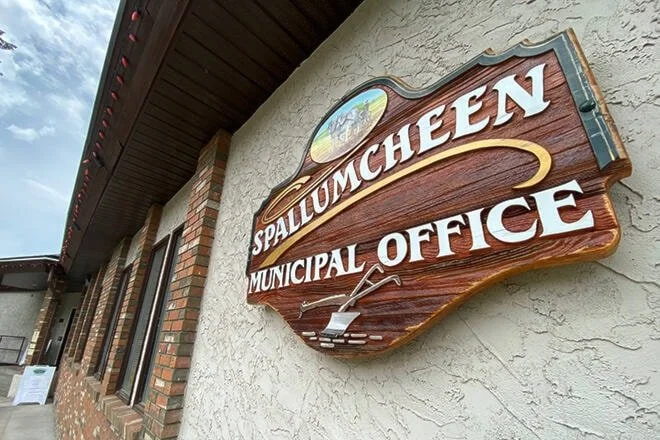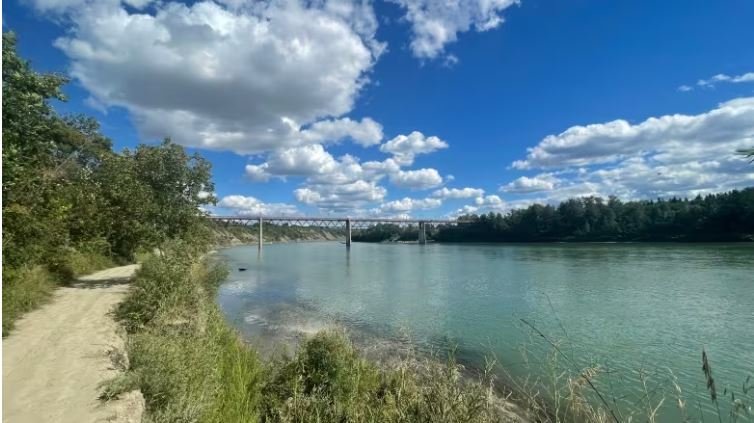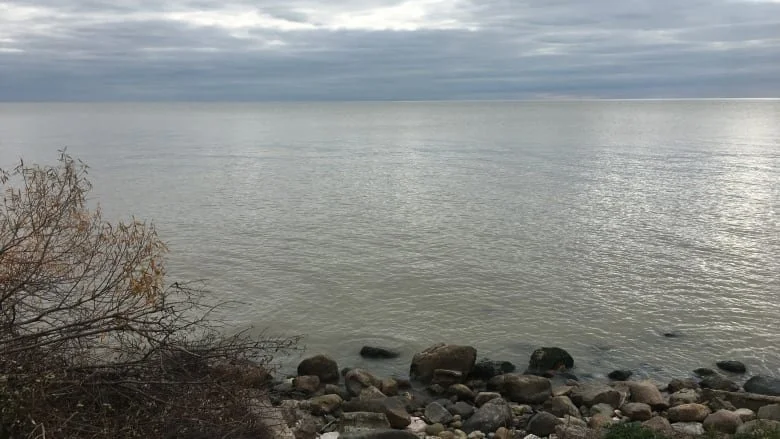Water is life, water is food, leave no one behind. That’s the theme of a conference taking place in Vancouver Monday that brings together experts and policymakers to tackle water scarcity, and to find ways to protect this vital resource as the planet heats up from global warming. UBC, SFU and the UN’s Food and Agricultural Organization are hosting the official North America World Food Day event at the Morris J. Wosk Centre for Dialogue.
'The saving grace for agriculture': Farmers look to irrigation amid climate woes
Sean Stanford's wheat farm just south of Lethbridge, Alta. falls within the far left corner of Palliser's Triangle — an expanse of prairie grassland encompassing much of southeast Alberta, a swath of southern Saskatchewan, and the southwest corner of Manitoba. The area is named for explorer Capt. John Palliser, who in 1857, famously declared the entire region a wasteland — so hot and arid that no crops would ever grow.
Okanagan has one of the highest water use rates per person in Canada
A community consulting firm is asking, ‘Water you doing, Spall?’ The Township of Spallumcheen is looking to get the word out about the critical importance of water conservation. According to Spall reports, the Okanagan has one of the highest rates of water use per person in Canada, meaning there is less water available per person in the Okanagan than anywhere else in the country.
Governments Strengthening Agricultural Productivity and Sustainability
In addition, the On-Farm Applied Research and Monitoring (ONFARM) program will be expanded and enhanced by an additional $7 million over five years. This program is a continuation from the Canadian Agricultural Partnership and will help farmers understand and communicate best on-farm practices to address and improve their soil health and water quality.
An Indigenous approach to understanding water
“siwɬkʷ (WATER) IS SACRED AND IS LIFE FOR ALL PEOPLE. We know from our histories and our knowledge that water is one of the most important resources available to humans and animals.” But for Dawn Machin and Sarah Alexis, both from snƛ̓x̌ʷx̌ʷtan (Six-Mile Creek area in the North Arm of Okanagan Lake), there’s a disconnect between what water represents to humanity and how it’s perceived.
Canadian Prairies farmers try to adapt to a warming world
Most canola crops are grown without requiring irrigation in the Prairies, the nation's agricultural heartland spanning nearly 1.8 million square kilometers (695,000 square miles). But the region is sensitive to droughts, whose frequency and severity have been steadily increasing. In this region, explains Phillip Harder, a hydrology researcher at the University of Saskatchewan, in Saskatoon, "crop production relies on water that accumulates throughout the year." In other words, snow that accumulates over winter and soaks into the ground during the spring thaw. But howling winds over fields that stretch as far as the eye can see have been blowing away much of that snow of late.
Kelowna has some of the best tap water in the world
Of course Kelowna residents take their water for granted. It's plentiful, clean and cheap. And, as such, we tend to let it flow freely from the tap with hardly a second thought. "Yes, Canadians use a lot of water per capita," said City of Kelowna utility services manager Kevin Van Vliet. "And, in the Okanagan, we're some of the biggest per capita users in Canada because of the irrigation used for agriculture in our hot, dry climate."
How the health of a river is influenced by what's happening on land
For some residents of northern Alberta and Saskatchewan, the North Saskatchewan River is nothing more than a flowing body of water that starts at the Saskatchewan Glacier in Banff National Park and winds its way northeast. But it's much more than that. The river is a part of a bigger network of streams and channels that feed into it on its path through the Prairies. We're talking about a watershed — an area of land that drains into a water body.
An American water crisis
These are desperate days for the Colorado River. The pulsing lifeblood of the U.S. southwest is increasingly parched. To avert catastrophe, the U.S. government will, within weeks, propose historic cuts in water access. It’s a frantic move to protect a river that provides so much: drinking water for tens of millions of people, electricity and food. Lots of food. This indispensable waterway supplies farms that feed hundreds of millions of people, throughout the continent — including Canadians.
Experts root for agrivoltaics to solve clean energy, agricultural needs
Mindorff discussed the benefits of agrivoltaics, which he described as a hybrid agricultural system that maximizes land use and reduces water consumption while providing clean and affordable energy. Among the benefits is the potential to increase crop yields, while reducing water and fertilizer requirements as well as provide growers with additional income generated through selling solar electricity.
2nd blue-green algae bloom found on P.E.I., this time in Murray River
P.E.I. issued another blue-green algae bloom advisory on Wednesday, after the microscopic organisms causing the phenomenon were found in Murray River's MacLures Pond. Just a day before, the province announced it had discovered blue-green algae in Black Pond near Souris. That was the first time in two years that such a bloom had been reported in the province.
How has federal protection helped Lake Superior?
The biggest of the Great Lakes and one of the largest freshwater ecosystems in the world — has remained relatively pristine compared to the other four. It’s far enough away from the populated urban centres in southern Ontario, its watersheds are largely forested, there’s little industry or agriculture on its shorelines and its especially cold water (an average of 4 C year-round) has kept away invasive species.
Hamilton-area corn producers optimistic despite dry July
Local corn has arrived in stores and farmers markets throughout the Hamilton area. And while growing conditions have been less than ideal, producers remain optimistic for another strong season, thanks to some much-needed rain and extra irrigation. Through July 26, Hamilton had received just 56.3 mm of precipitation for the month, compared to 99.1 mm in July 2021.
End of moratorium on high-capacity irrigation wells brings 'model of fairness'
Starting June 11, farmers on P.E.I. will be able to apply to the provincial government for a licence to drill a high-capacity well to water their crops. A moratorium on high-capacity wells for agriculture has been in place since 2002. Other industries — such as golf courses and food processors — have been free to apply and drill wells. "There's a model of fairness built into this that farmers can finally apply for water, because they were the only ones who couldn't," said Environment Minister Steven Myers
The window of opportunity to address increasing drought and expanding drylands is vanishing
Chile, Argentina and the American West are in the midst of a decade-long, megadrought – the driest conditions those regions have seen in a century. And many areas in Western Canada and the United States are experiencing extreme drought – a once in 20-year event. Drought makes agriculture less productive, reduces crop yields and increases heat-related deaths. It adds to conflict and migration, as marginalized people are dispossessed of their land. In short, it leaves people more vulnerable.
Canada's growing thirst for Aussie water revealed
Canadian investors own about two Sydney Harbour's worth of Aussie water. Super funds from Canada have a well known thirst for irrigation water where agriculture is concerned. The Canadian slice of Australian water has risen by 282 per cent in four years. The Canadians have stayed well out in front in terms of the top 10 overseas countries with the biggest stake in Australian water.
Could vertical farming solve Canada's food supply chain issues?
Vertical farming software meticulously manages climate, irrigation and LED light luminance to control crop cultivation much more efficiently than outdoor or greenhouse farming, removing guess work from growing. “The amount of water we use on an annual basis is less than five per cent of what it would be in a greenhouse,” Krochmalnek told CTV News Toronto. “In a greenhouse, you have to water multiple times a day. We water twice per week. Our crop success rate is 99.5 per cent in terms of the yield we expect versus what we get, every harvest. That makes vertical farming very predictable,” he added.
Windsor engineer worried about climate change's impact on water quality in the Great Lakes
A Windsor-based engineer said climate change is taking a toll on the health of the Great Lakes and this could in turn have an impact on the quality of drinking water for millions of people. Saad Jasim, who is also president of the International Ozone Association, said the impact of climate change on the Great Lakes is quite visible in the form of harmful algal blooms. "But it's not just the way it looks, these algal blooms produce some fatal toxins … there are different species of those toxins [and] unfortunately only one of the species is regulated by Health Canada," Jasim told CBC Windsor.
To be resilient, the Canadian Prairie needs lots of wetlands
In the Canadian Prairies, wetland drainage has resulted in the loss of more than 40 percent of natural wetlands. The impacts associated with this drainage are largely unmitigated. Wetlands are key ecosystem features that provide numerous services, like water purification, that are integral to social and ecological systems. Because wetlands occur largely in depressions, they regulate stream flow by acting as reservoirs for snow and rain, and many are places where groundwater can be replenished. In the prairie climate, the presence of water lends these systems to being a crucial habitat for many organisms.
Irrigation shows early promise for reducing nitrate pollution from farms
Preliminary research on P.E.I. farms shows that irrigating potatoes helps the plants better use nitrogen in fertilizer, so it doesn't end up leaching into the environment. The research by the Living Lab Project — a partnership of Agriculture Canada, the East Prince Agri-Environment Association and the P.E.I. Department of Agriculture — is in its third year. Provincial soil and water conservation engineer Tobin Stetson said the early field trial results are replicating results from previous federal research farm testing.





















